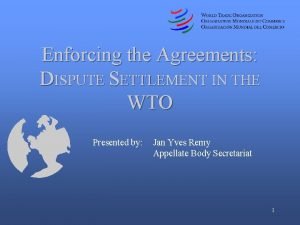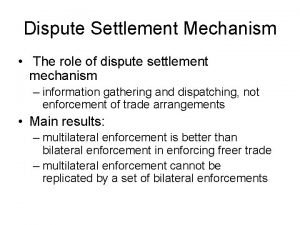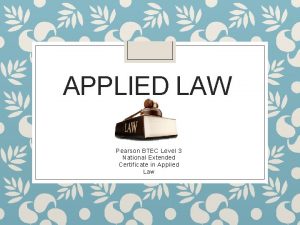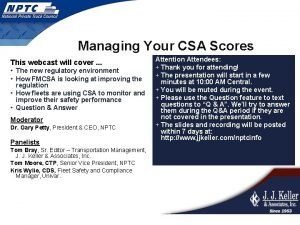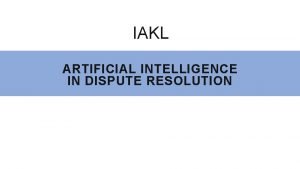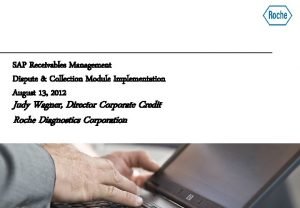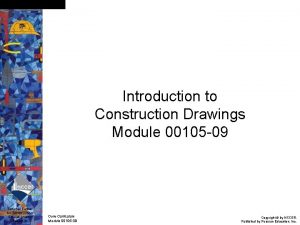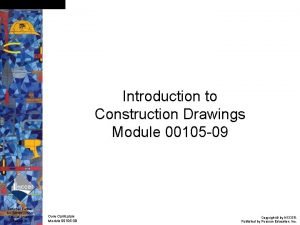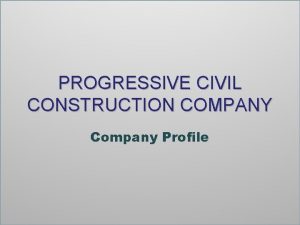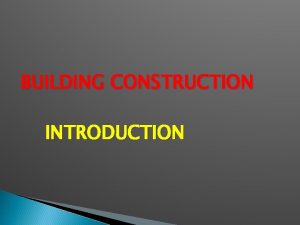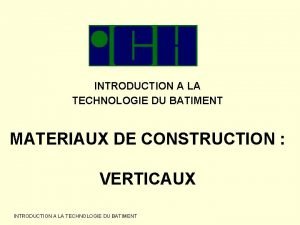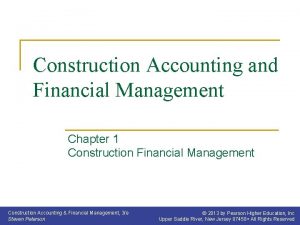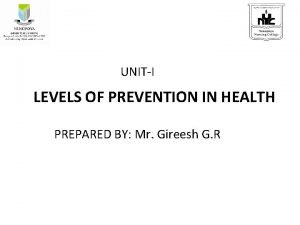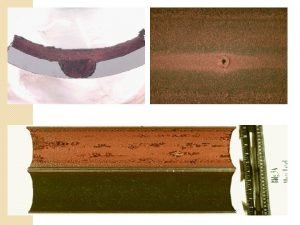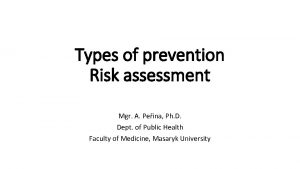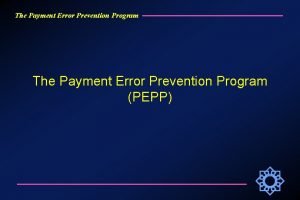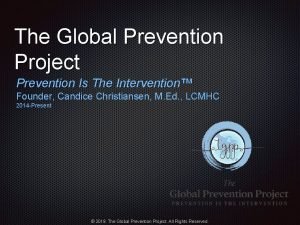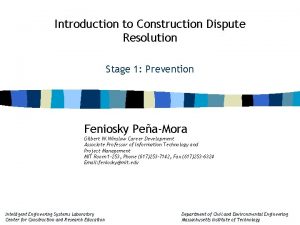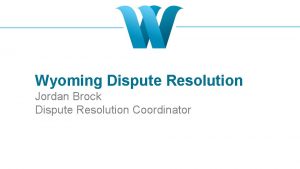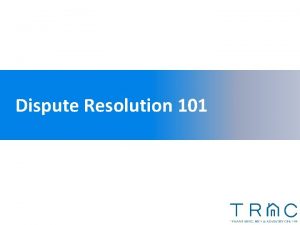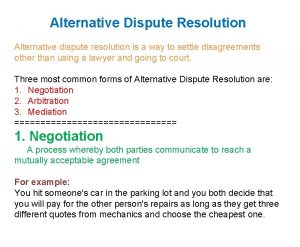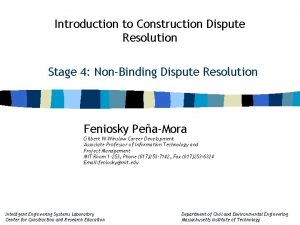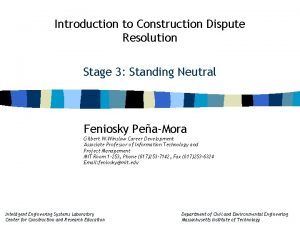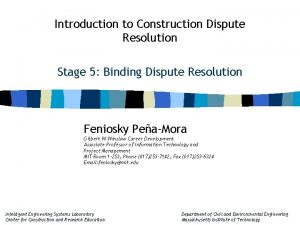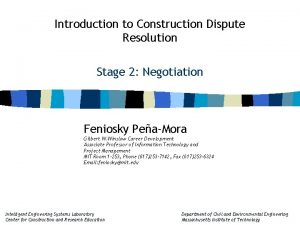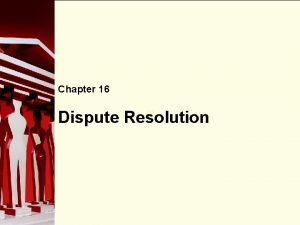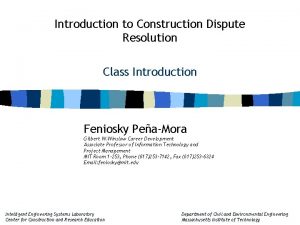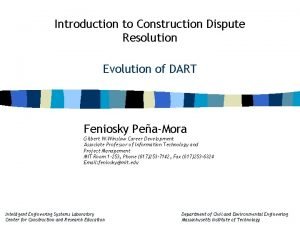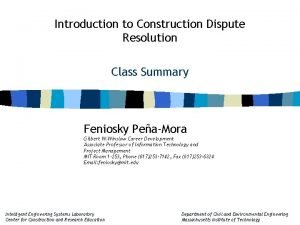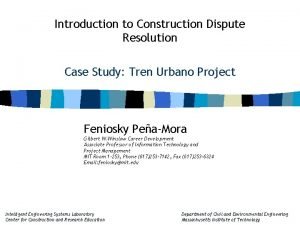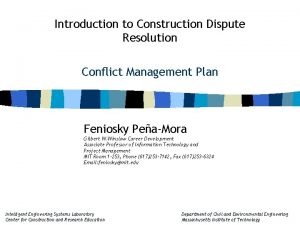Introduction to Construction Dispute Resolution Stage 1 Prevention















































![References n n n n n 48 n [Appelbaum, 1998] : Appelbaum, Jeffrey. "Bridging" References n n n n n 48 n [Appelbaum, 1998] : Appelbaum, Jeffrey. "Bridging"](https://slidetodoc.com/presentation_image_h2/fb934c019e3c98cdf5123917f45f33b6/image-48.jpg)
- Slides: 48

Introduction to Construction Dispute Resolution Stage 1: Prevention Feniosky Peña-Mora Gilbert W. Winslow Career Development Associate Professor of Information Technology and Project Management MIT Room 1 -253, Phone (617)253 -7142, Fax (617)253 -6324 Email: feniosky@mit. edu Intelligent Engineering Systems Laboratory Center for Construction and Research Education Department of Civil and Environmental Engineering Massachusetts Institute of Technology

Outline ü ü Ø n n n 2 n Importance of Prevention Stage Equitable Risk Sharing ü ü ü Economic Price Adjustment Geotechnical Baseline Report (GBR) Third Party Beneficiary Clause ü ü ü Negotiated Compressed Process A+B Bidding PEp. C Delivery System “Bridging” the Design-Build Gap Frame Contract Delivery System in the Netherlands • • • Cost/Schedule Incentive Matrix Subjective Determination of Fee Superior Time Management Allowance • Constructability Analysis • • • Cost Statement Submittal Certified Payroll Submittal Negotiated Equipment and Labor Pricing Joint Project Scheduling Schedule Audits As-Built Schedule Submittal Forward-Price Change Orders Right of Refusal on Change-Order Cost Quotations Sub-Contractor Payment Requirements Escrow Bid Documents Project Award and Delivery Mechanism Incentive Programs Competent Engineering and Documentation Cost and Schedule Control Dispute Resolution Clauses Training and Development Introduction to Construction Dispute Resolution Chapter 3: Prevention © Peña-Mora, et. al. 2002

Incentive Programs n Incentive Programs Promoting Objective Alignment n Attainable Yet Challenging Goals Fixed by the Owner to the Construction Team n Continuous Evaluation of Contractor’s Performance Against Set Goals 3 Introduction to Construction Dispute Resolution Chapter 3: Prevention © Peña-Mora, et. al. 2002

Outline ü ü ü n n n 4 n Importance of Prevention Stage Equitable Risk Sharing ü ü ü Economic Price Adjustment Geotechnical Baseline Report (GBR) Third Party Beneficiary Clause ü ü ü Negotiated Compressed Process A+B Bidding PEp. C Delivery System “Bridging” the Design-Build Gap Frame Contract Delivery System in the Netherlands Ø • • Cost/Schedule Incentive Matrix Subjective Determination of Fee Superior Time Management Allowance • Constructability Analysis • • • Cost Statement Submittal Certified Payroll Submittal Negotiated Equipment and Labor Pricing Joint Project Scheduling Schedule Audits As-Built Schedule Submittal Forward-Price Change Orders Right of Refusal on Change-Order Cost Quotations Sub-Contractor Payment Requirements Escrow Bid Documents Project Award and Delivery Mechanism Incentive Programs Competent Engineering and Documentation Cost and Schedule Control Dispute Resolution Clauses Training and Development Introduction to Construction Dispute Resolution Chapter 3: Prevention © Peña-Mora, et. al. 2002

Cost/Schedule Incentive Matrix n A Value Matrix to Associate a Dollar Value for Early Completion, Good Performance and Cost Underruns n A Monetary Reward to the Contractor According to the Dollar Value 5 Introduction to Construction Dispute Resolution Chapter 3: Prevention © Peña-Mora, et. al. 2002

Incentive Matrix and Objective Alignment Owner Objectives (Categories) Contractor Objectives before Incentive Program Contractor Objectives after Incentive Program Complete the Project under Budget (COST) Meet Cost Estimate, Cashflow Requirements and Projected Fee Meet Cash Flow, Fee and Maximize Cost Savings Complete the Project ahead of Schedule (SCHEDULE) Meet Schedule Datelines without Additional Costs Complete Project ahead of Schedule, even if it Represents some Additional Costs, which Would be Offset by the Bonus Reduce the Owner Overhead Costs (OVERHEAD) Not Concerned as Long as Owner is Able to Respond Technically and Administratively to its Demands Collaborate with Owner in Solving Technical and Administrative Problems to Reduce Overhead 6 Introduction to Construction Dispute Resolution Chapter 3: Prevention © Peña-Mora, et. al. 2002

Outline ü ü ü n n n 7 n Importance of Prevention Stage Equitable Risk Sharing ü ü ü Economic Price Adjustment Geotechnical Baseline Report (GBR) Third Party Beneficiary Clause ü ü ü Negotiated Compressed Process A+B Bidding PEp. C Delivery System “Bridging” the Design-Build Gap Frame Contract Delivery System in the Netherlands ü Ø • Cost/Schedule Incentive Matrix Subjective Determination of Fee Superior Time Management Allowance • Constructability Analysis • • • Cost Statement Submittal Certified Payroll Submittal Negotiated Equipment and Labor Pricing Joint Project Scheduling Schedule Audits As-Built Schedule Submittal Forward-Price Change Orders Right of Refusal on Change-Order Cost Quotations Sub-Contractor Payment Requirements Escrow Bid Documents Project Award and Delivery Mechanism Incentive Programs Competent Engineering and Documentation Cost and Schedule Control Dispute Resolution Clauses Training and Development Introduction to Construction Dispute Resolution Chapter 3: Prevention © Peña-Mora, et. al. 2002

Subjective Determination of Fee n Basing Part of the Construction Fee on Periodic Engineering and/or Construction Performance Evaluations Done by the Owner n Subjective Evaluations Done by the Owner Allowing to Address Areas not Covered in the Contracts 8 Introduction to Construction Dispute Resolution Chapter 3: Prevention © Peña-Mora, et. al. 2002

Example n Cost-plus-fee Project n Contractor’s Fee: 15% Fixed Amount, 15% Based on Actual Man-hours in Engineering Activities, 35% Tied to performance in Engineering, 35% Tied to Performance in the Construction Phase n Quarterly Subjective Evaluations of Project Performance n A Minimum Score Set as a Payment Requirement n Possibility of Recuperation of Loss Income From Previous Months by Showing a Superior Performance Subsequently 9 Introduction to Construction Dispute Resolution Chapter 3: Prevention © Peña-Mora, et. al. 2002

Outline ü ü ü n n n 10 n Importance of Prevention Stage Equitable Risk Sharing ü ü ü Economic Price Adjustment Geotechnical Baseline Report (GBR) Third Party Beneficiary Clause ü ü ü Negotiated Compressed Process A+B Bidding PEp. C Delivery System “Bridging” the Design-Build Gap Frame Contract Delivery System in the Netherlands ü ü Ø Cost/Schedule Incentive Matrix Subjective Determination of Fee Superior Time Management Allowance • Constructability Analysis • • • Cost Statement Submittal Certified Payroll Submittal Negotiated Equipment and Labor Pricing Joint Project Scheduling Schedule Audits As-Built Schedule Submittal Forward-Price Change Orders Right of Refusal on Change-Order Cost Quotations Sub-Contractor Payment Requirements Escrow Bid Documents Project Award and Delivery Mechanism Incentive Programs Competent Engineering and Documentation Cost and Schedule Control Dispute Resolution Clauses Training and Development Introduction to Construction Dispute Resolution Chapter 3: Prevention © Peña-Mora, et. al. 2002

Superior Time-Management Allowance n Fixed Bonus for Early Completion n Incentive to Finish on Time and Disincentive to Submit Delay Claims 11 Introduction to Construction Dispute Resolution Chapter 3: Prevention © Peña-Mora, et. al. 2002

I-5 Interchange in Oregon n Construction of the I-5 Interchange at Highway 217 and Kruse Way Modernization Project n Owner: Oregon Department of Transportation n Contractor’s Estimate of Project Duration: 475 Days. n Incentive Program: $10, 000 per Day Incentive for Early Completion, and a $10, 000 per Day Penalty for Late Completion n Results: Project Completion 56 Days Ahead of Schedule 12 Introduction to Construction Dispute Resolution Chapter 3: Prevention © Peña-Mora, et. al. 2002

Outline ü ü ü n n 13 n Importance of Prevention Stage Equitable Risk Sharing ü ü ü Economic Price Adjustment Geotechnical Baseline Report (GBR) Third Party Beneficiary Clause ü ü ü Negotiated Compressed Process A+B Bidding PEp. C Delivery System “Bridging” the Design-Build Gap Frame Contract Delivery System in the Netherlands ü ü ü Cost/Schedule Incentive Matrix Subjective Determination of Fee Superior Time Management Allowance Ø Constructability Analysis • • • Cost Statement Submittal Certified Payroll Submittal Negotiated Equipment and Labor Pricing Joint Project Scheduling Schedule Audits As-Built Schedule Submittal Forward-Price Change Orders Right of Refusal on Change-Order Cost Quotations Sub-Contractor Payment Requirements Escrow Bid Documents Project Award and Delivery Mechanism Incentive Programs Competent Engineering and Documentation Cost and Schedule Control Dispute Resolution Clauses Training and Development Introduction to Construction Dispute Resolution Chapter 3: Prevention © Peña-Mora, et. al. 2002

Constructability Analysis n Performed during the Planning, Design and Procurement Phases n Prevention of Disagreements and disputes Based on Contract Ambiguities 14 Introduction to Construction Dispute Resolution Chapter 3: Prevention © Peña-Mora, et. al. 2002

Pavement Rehabilitation in California n Constructability and Productivity Analysis for the Caltrans’ Long Life Pavement Rehabilitation Strategies n Study of the Effect of Different Parameters Such As Rehabilitation Materials and Design Profiles. n Development of Prototype Constructibility Analysis Programs 15 Introduction to Construction Dispute Resolution Chapter 3: Prevention © Peña-Mora, et. al. 2002

Outline ü ü ü Ø n 16 n Importance of Prevention Stage Equitable Risk Sharing ü ü ü Economic Price Adjustment Geotechnical Baseline Report (GBR) Third Party Beneficiary Clause ü ü ü Negotiated Compressed Process A+B Bidding PEp. C Delivery System “Bridging” the Design-Build Gap Frame Contract Delivery System in the Netherlands ü ü ü Cost/Schedule Incentive Matrix Subjective Determination of Fee Superior Time Management Allowance ü Constructability Analysis • • • Cost Statement Submittal Certified Payroll Submittal Negotiated Equipment and Labor Pricing Joint Project Scheduling Schedule Audits As-Built Schedule Submittal Forward-Price Change Orders Right of Refusal on Change-Order Cost Quotations Sub-Contractor Payment Requirements Escrow Bid Documents Project Award and Delivery Mechanism Incentive Programs Competent Engineering and Documentation Cost and Schedule Control Dispute Resolution Clauses Training and Development Introduction to Construction Dispute Resolution Chapter 3: Prevention © Peña-Mora, et. al. 2002

Cost and Schedule Control n Dispute Management Technique Used by the Public Sector in Italy: Pro-active Approach Site Representative prepares monthly report (SAL) Contractor reviews and approves SAL report If no claims during period If claims develop and/or they remain outstanding Negotiations to resolve claims. Outstanding claims have to be included subsequent SAL reports SAL report is incoporated to the request for progress payment Once claims are reported and documented Claims need to be incorporated into SAL report If claim exceeds 10% of contract Head Public Official must review claim with contractor and site rep. Proposal for amicable settlement presented by owner to contractor 90 days Negotiations to settle Arbitration can be requested by either party at the end of the project for any otustanding claims 60 days 17 Introduction to Construction Dispute Resolution Chapter 3: Prevention © Peña-Mora, et. al. 2002

Cost and Schedule Control n Rationale Behind the Previous Dispute Management Technique • Problematic Issues Addressed on a Regular Basis • Evaluation of the Effect of Outstanding Claim on the Rest of the Project • Specific Time Periods for the Negotiation of Complex Claims • On-site Representative and Contractor Attempting Claim Settlement and Their Elimination From Every SAL Report • Promotion of Negotiation Prior to Litigation 18 Introduction to Construction Dispute Resolution Chapter 3: Prevention © Peña-Mora, et. al. 2002

Air Canada Center Case n 20% Increase in the Amount of Work without Modification of the Original Completion Date n Common Negotiation and Changes Approval n Introduction of Separate Night Crew for 3 Months 19 Introduction to Construction Dispute Resolution Chapter 3: Prevention © Peña-Mora, et. al. 2002

Outline ü ü ü ü n 20 n Importance of Prevention Stage Equitable Risk Sharing ü ü ü Economic Price Adjustment Geotechnical Baseline Report (GBR) Third Party Beneficiary Clause ü ü ü Negotiated Compressed Process A+B Bidding PEp. C Delivery System “Bridging” the Design-Build Gap Frame Contract Delivery System in the Netherlands ü ü ü Cost/Schedule Incentive Matrix Subjective Determination of Fee Superior Time Management Allowance ü Constructability Analysis Ø • • Cost Statement Submittal Certified Payroll Submittal Negotiated Equipment and Labor Pricing Joint Project Scheduling Schedule Audits As-Built Schedule Submittal Forward-Price Change Orders Right of Refusal on Change-Order Cost Quotations Sub-Contractor Payment Requirements Escrow Bid Documents Project Award and Delivery Mechanism Incentive Programs Competent Engineering and Documentation Cost and Schedule Control Dispute Resolution Clauses Training and Development Introduction to Construction Dispute Resolution Chapter 3: Prevention © Peña-Mora, et. al. 2002

Cost Statement Submittal n Certified Statement of Costs Incurred Submitted by the Contractor Before the Issuance of Certificate of Final Completion n More Accurate Review and Faster Negotiation of After-completion Claims 21 Introduction to Construction Dispute Resolution Chapter 3: Prevention © Peña-Mora, et. al. 2002

Outline ü ü ü ü n 22 n Importance of Prevention Stage Equitable Risk Sharing ü ü ü Economic Price Adjustment Geotechnical Baseline Report (GBR) Third Party Beneficiary Clause ü ü ü Negotiated Compressed Process A+B Bidding PEp. C Delivery System “Bridging” the Design-Build Gap Frame Contract Delivery System in the Netherlands ü ü ü Cost/Schedule Incentive Matrix Subjective Determination of Fee Superior Time Management Allowance ü Constructability Analysis ü Ø • • Cost Statement Submittal Certified Payroll Submittal Negotiated Equipment and Labor Pricing Joint Project Scheduling Schedule Audits As-Built Schedule Submittal Forward-Price Change Orders Right of Refusal on Change-Order Cost Quotations Sub-Contractor Payment Requirements Escrow Bid Documents Project Award and Delivery Mechanism Incentive Programs Competent Engineering and Documentation Cost and Schedule Control Dispute Resolution Clauses Training and Development Introduction to Construction Dispute Resolution Chapter 3: Prevention © Peña-Mora, et. al. 2002

Certified Payroll Submittal n Keep Record of Labor Expenditure n Assess Progress and Identify Delays n Find Early Remedial Action Plan 23 Introduction to Construction Dispute Resolution Chapter 3: Prevention © Peña-Mora, et. al. 2002

Example: The CQS 24 Introduction to Construction Dispute Resolution Chapter 3: Prevention © Peña-Mora, et. al. 2002

Outline ü ü ü ü n 25 n Importance of Prevention Stage Equitable Risk Sharing ü ü ü Economic Price Adjustment Geotechnical Baseline Report (GBR) Third Party Beneficiary Clause ü ü ü Negotiated Compressed Process A+B Bidding PEp. C Delivery System “Bridging” the Design-Build Gap Frame Contract Delivery System in the Netherlands ü ü ü Cost/Schedule Incentive Matrix Subjective Determination of Fee Superior Time Management Allowance ü Constructability Analysis ü ü Ø • • • Cost Statement Submittal Certified Payroll Submittal Negotiated Equipment and Labor Pricing Joint Project Scheduling Schedule Audits As-Built Schedule Submittal Forward-Price Change Orders Right of Refusal on Change-Order Cost Quotations Sub-Contractor Payment Requirements Escrow Bid Documents Project Award and Delivery Mechanism Incentive Programs Competent Engineering and Documentation Cost and Schedule Control Dispute Resolution Clauses Training and Development Introduction to Construction Dispute Resolution Chapter 3: Prevention © Peña-Mora, et. al. 2002

Negotiated Equipment and Labor Pricing n Negotiation of Unit Prices for Equipment and Labor before Contract Award n Agreement on Unit Prices for Typical Work Items n Agreement on Sources of Pricing Information Before-hand n Elimination of Uncertainty Associated with Change Orders Being Priced After Execution 26 Introduction to Construction Dispute Resolution Chapter 3: Prevention © Peña-Mora, et. al. 2002

Outline ü ü ü ü n 27 n Importance of Prevention Stage Equitable Risk Sharing ü ü ü Economic Price Adjustment Geotechnical Baseline Report (GBR) Third Party Beneficiary Clause ü ü ü Negotiated Compressed Process A+B Bidding PEp. C Delivery System “Bridging” the Design-Build Gap Frame Contract Delivery System in the Netherlands ü ü ü Cost/Schedule Incentive Matrix Subjective Determination of Fee Superior Time Management Allowance ü Constructability Analysis ü ü ü Ø • • • Cost Statement Submittal Certified Payroll Submittal Negotiated Equipment and Labor Pricing Joint Project Scheduling Schedule Audits As-Built Schedule Submittal Forward-Price Change Orders Right of Refusal on Change-Order Cost Quotations Sub-Contractor Payment Requirements Escrow Bid Documents Project Award and Delivery Mechanism Incentive Programs Competent Engineering and Documentation Cost and Schedule Control Dispute Resolution Clauses Training and Development Introduction to Construction Dispute Resolution Chapter 3: Prevention © Peña-Mora, et. al. 2002

Joint Project Scheduling Joint Development of Baseline Program between Participants n Advantages n • Elimination of Schedule Games (Hidden Float, Change of Sequence, Front-Loading) • Communication and Collaboration During the Planning Stages • Negotiation of Delays Once They Occur in Schedule Updates • Schedule Reviews and Change Order Impact Assessment Performed in Parallel in Order to Reduce the Chances of Future Delay Claims and Disruption Disputes n Example: Nestle Chocolates Case • Master Schedule • Biweekly Updates 28 Introduction to Construction Dispute Resolution Chapter 3: Prevention © Peña-Mora, et. al. 2002

Outline ü ü ü ü n 29 n Importance of Prevention Stage Equitable Risk Sharing ü ü ü Economic Price Adjustment Geotechnical Baseline Report (GBR) Third Party Beneficiary Clause ü ü ü Negotiated Compressed Process A+B Bidding PEp. C Delivery System “Bridging” the Design-Build Gap Frame Contract Delivery System in the Netherlands ü ü ü Cost/Schedule Incentive Matrix Subjective Determination of Fee Superior Time Management Allowance ü Constructability Analysis ü ü Ø • • Cost Statement Submittal Certified Payroll Submittal Negotiated Equipment and Labor Pricing Joint Project Scheduling Schedule Audits As-Built Schedule Submittal Forward-Price Change Orders Right of Refusal on Change-Order Cost Quotations Sub-Contractor Payment Requirements Escrow Bid Documents Project Award and Delivery Mechanism Incentive Programs Competent Engineering and Documentation Cost and Schedule Control Dispute Resolution Clauses Training and Development Introduction to Construction Dispute Resolution Chapter 3: Prevention © Peña-Mora, et. al. 2002

Schedule Audits n Goal: Early Identification of Delays to Prevent Repercussion on Subsequent Activities n Problems Associated with Monthly schedule Updates: • Risk of Late Delay Identification • Discrepancy between Monthly Schedule Updates and Asbuilt Schedule for Payment Considerations n Solution : • Separation of Payment Request from Real Schedule Updates and Reviews 30 • Weekly or Biweekly Schedule Updates Introduction to Construction Dispute Resolution Chapter 3: Prevention © Peña-Mora, et. al. 2002

Outline ü ü ü ü n 31 n Importance of Prevention Stage Equitable Risk Sharing ü ü ü Economic Price Adjustment Geotechnical Baseline Report (GBR) Third Party Beneficiary Clause ü ü ü Negotiated Compressed Process A+B Bidding PEp. C Delivery System “Bridging” the Design-Build Gap Frame Contract Delivery System in the Netherlands ü ü ü Cost/Schedule Incentive Matrix Subjective Determination of Fee Superior Time Management Allowance ü Constructability Analysis ü ü ü Ø • • • Cost Statement Submittal Certified Payroll Submittal Negotiated Equipment and Labor Pricing Joint Project Scheduling Schedule Audits As-Built Schedule Submittal Forward-Price Change Orders Right of Refusal on Change-Order Cost Quotations Sub-Contractor Payment Requirements Escrow Bid Documents Project Award and Delivery Mechanism Incentive Programs Competent Engineering and Documentation Cost and Schedule Control Dispute Resolution Clauses Training and Development Introduction to Construction Dispute Resolution Chapter 3: Prevention © Peña-Mora, et. al. 2002

As-Built Schedule Submittal n As-Built Schedule before Issuance of Certificate of Final Completion and Release of Retention n As-Built Schedule as the Basis for Review of After-completion Claims 32 Introduction to Construction Dispute Resolution Chapter 3: Prevention © Peña-Mora, et. al. 2002

Outline ü ü ü ü n 33 n Importance of Prevention Stage Equitable Risk Sharing ü ü ü Economic Price Adjustment Geotechnical Baseline Report (GBR) Third Party Beneficiary Clause ü ü ü Negotiated Compressed Process A+B Bidding PEp. C Delivery System “Bridging” the Design-Build Gap Frame Contract Delivery System in the Netherlands ü ü ü Cost/Schedule Incentive Matrix Subjective Determination of Fee Superior Time Management Allowance ü Constructability Analysis ü ü ü Ø • • Cost Statement Submittal Certified Payroll Submittal Negotiated Equipment and Labor Pricing Joint Project Scheduling Schedule Audits As-Built Schedule Submittal Forward-Price Change Orders Right of Refusal on Change-Order Cost Quotations Sub-Contractor Payment Requirements Escrow Bid Documents Project Award and Delivery Mechanism Incentive Programs Competent Engineering and Documentation Cost and Schedule Control Dispute Resolution Clauses Training and Development Introduction to Construction Dispute Resolution Chapter 3: Prevention © Peña-Mora, et. al. 2002

Forward-Price Change Orders n Impact or Indirect Costs Identified beforehand n Development of Impact Factors for Issues Like Timing of Changes, Number of Trades Involved, Effect on the Schedule, Effect on Office and Field Staffing, Cumulative Nature of the Disruption n Distinction between Impact Costs and Hard Costs 34 Introduction to Construction Dispute Resolution Chapter 3: Prevention © Peña-Mora, et. al. 2002

The FEMA Methodology § Forward Pricing Methodology Called the Cost. Estimating Format (CEF) and Developed by the Federal Emergency Management Agency § Forward Pricing for All kinds of Disasters § CEF Composed of 8 Parts: A (representative of subcontractor(s) construction efforts), B to E (the general contractor or equivalent nonconstruction costs), F to H (owner's markups and non-construction costs) 35 Introduction to Construction Dispute Resolution Chapter 3: Prevention © Peña-Mora, et. al. 2002

Outline ü ü ü ü n 36 n Importance of Prevention Stage Equitable Risk Sharing ü ü ü Economic Price Adjustment Geotechnical Baseline Report (GBR) Third Party Beneficiary Clause ü ü ü Negotiated Compressed Process A+B Bidding PEp. C Delivery System “Bridging” the Design-Build Gap Frame Contract Delivery System in the Netherlands ü ü ü Cost/Schedule Incentive Matrix Subjective Determination of Fee Superior Time Management Allowance ü Constructability Analysis ü ü ü ü Ø • Cost Statement Submittal Certified Payroll Submittal Negotiated Equipment and Labor Pricing Joint Project Scheduling Schedule Audits As-Built Schedule Submittal Forward-Price Change Orders Right of Refusal on Change-Order Cost Quotations Sub-Contractor Payment Requirements Escrow Bid Documents Project Award and Delivery Mechanism Incentive Programs Competent Engineering and Documentation Cost and Schedule Control Dispute Resolution Clauses Training and Development Introduction to Construction Dispute Resolution Chapter 3: Prevention © Peña-Mora, et. al. 2002

Right of Refusal on Change-Order Cost Quotations n Reservation-of-right in Change Orders for Future Request of Time or Money n Good Practice: Allowing the Contractor to Refuse to Quote Change Orders if a Delay is Expected 37 Introduction to Construction Dispute Resolution Chapter 3: Prevention © Peña-Mora, et. al. 2002

Outline ü ü ü ü n 38 n Importance of Prevention Stage Equitable Risk Sharing ü ü ü Economic Price Adjustment Geotechnical Baseline Report (GBR) Third Party Beneficiary Clause ü ü ü Negotiated Compressed Process A+B Bidding PEp. C Delivery System “Bridging” the Design-Build Gap Frame Contract Delivery System in the Netherlands ü ü ü Cost/Schedule Incentive Matrix Subjective Determination of Fee Superior Time Management Allowance ü Constructability Analysis ü ü ü ü Ø Cost Statement Submittal Certified Payroll Submittal Negotiated Equipment and Labor Pricing Joint Project Scheduling Schedule Audits As-Built Schedule Submittal Forward-Price Change Orders Right of Refusal on Change-Order Cost Quotations Sub-Contractor Payment Requirements Escrow Bid Documents Project Award and Delivery Mechanism Incentive Programs Competent Engineering and Documentation Cost and Schedule Control Dispute Resolution Clauses Training and Development Introduction to Construction Dispute Resolution Chapter 3: Prevention © Peña-Mora, et. al. 2002

Sub-Contractor Payment Requirements n Certification of Subcontractors’ Payment n Owner’s Right for Direct Payment to Subcontractors 39 Introduction to Construction Dispute Resolution Chapter 3: Prevention © Peña-Mora, et. al. 2002

Example: The Delaware DOT n Prompt Payment Clause To Guarantee Payment for Subcontractor n Retainage Clause To Guarantee Satisfactory Completion of the Work by the Subcontractor 40 Introduction to Construction Dispute Resolution Chapter 3: Prevention © Peña-Mora, et. al. 2002

Outline ü ü ü ü Ø 41 n Importance of Prevention Stage Equitable Risk Sharing ü ü ü Economic Price Adjustment Geotechnical Baseline Report (GBR) Third Party Beneficiary Clause ü ü ü Negotiated Compressed Process A+B Bidding PEp. C Delivery System “Bridging” the Design-Build Gap Frame Contract Delivery System in the Netherlands ü ü ü Cost/Schedule Incentive Matrix Subjective Determination of Fee Superior Time Management Allowance ü Constructability Analysis ü ü ü ü ü Cost Statement Submittal Certified Payroll Submittal Negotiated Equipment and Labor Pricing Joint Project Scheduling Schedule Audits As-Built Schedule Submittal Forward-Price Change Orders Right of Refusal on Change-Order Cost Quotations Sub-Contractor Payment Requirements Escrow Bid Documents Project Award and Delivery Mechanism Incentive Programs Competent Engineering and Documentation Cost and Schedule Control Dispute Resolution Clauses Training and Development Introduction to Construction Dispute Resolution Chapter 3: Prevention © Peña-Mora, et. al. 2002

Dispute Resolution Clauses n Early Definition of a Depute Resolution System n Selection of Third Party Neutral 42 Introduction to Construction Dispute Resolution Chapter 3: Prevention © Peña-Mora, et. al. 2002

Outline ü ü ü ü 43 Ø Importance of Prevention Stage Equitable Risk Sharing ü ü ü Economic Price Adjustment Geotechnical Baseline Report (GBR) Third Party Beneficiary Clause ü ü ü Negotiated Compressed Process A+B Bidding PEp. C Delivery System “Bridging” the Design-Build Gap Frame Contract Delivery System in the Netherlands ü ü ü Cost/Schedule Incentive Matrix Subjective Determination of Fee Superior Time Management Allowance ü Constructability Analysis ü ü ü ü ü Cost Statement Submittal Certified Payroll Submittal Negotiated Equipment and Labor Pricing Joint Project Scheduling Schedule Audits As-Built Schedule Submittal Forward-Price Change Orders Right of Refusal on Change-Order Cost Quotations Sub-Contractor Payment Requirements Escrow Bid Documents Project Award and Delivery Mechanism Incentive Programs Competent Engineering and Documentation Cost and Schedule Control Dispute Resolution Clauses Training and Development Introduction to Construction Dispute Resolution Chapter 3: Prevention © Peña-Mora, et. al. 2002

Training and Development n Formal Training in Dispute Prevention and Resolution n Development of Negotiation Skills 44 Introduction to Construction Dispute Resolution Chapter 3: Prevention © Peña-Mora, et. al. 2002

Outline ü ü ü ü 45 ü Importance of Prevention Stage Equitable Risk Sharing ü ü ü Economic Price Adjustment Geotechnical Baseline Report (GBR) Third Party Beneficiary Clause ü ü ü Negotiated Compressed Process A+B Bidding PEp. C Delivery System “Bridging” the Design-Build Gap Frame Contract Delivery System in the Netherlands ü ü ü Cost/Schedule Incentive Matrix Subjective Determination of Fee Superior Time Management Allowance ü Constructability Analysis ü ü ü ü ü Cost Statement Submittal Certified Payroll Submittal Negotiated Equipment and Labor Pricing Joint Project Scheduling Schedule Audits As-Built Schedule Submittal Forward-Price Change Orders Right of Refusal on Change-Order Cost Quotations Sub-Contractor Payment Requirements Escrow Bid Documents Project Award and Delivery Mechanism Incentive Programs Competent Engineering and Documentation Cost and Schedule Control Dispute Resolution Clauses Training and Development Introduction to Construction Dispute Resolution Chapter 3: Prevention © Peña-Mora, et. al. 2002

Office Building Project n Proper Implementation of Preventive Measures: • GMP Style Contract • 50/50 Shared Savings of the Money Under the GMP With the Contractor • Threat of Liquidated Damages • Daily Phone Communications Between Owner and Contractor • Daily On-Site Meetings Between Contractor and Subcontractors • On-Site Inspection of Design • Visit of Architect to the Site Once or Twice a Week 46 Introduction to Construction Dispute Resolution Chapter 3: Prevention © Peña-Mora, et. al. 2002

Summary n Conflict Prevention : More Effective, Less Expensive and Less Time Consuming Than Conflict Resolution n Different Prevention Techniques But Many Common Denominators n Importance of the Recognition of a Potential Threat and the Commitment to Avoid it 47 Introduction to Construction Dispute Resolution Chapter 3: Prevention © Peña-Mora, et. al. 2002
![References n n n n n 48 n Appelbaum 1998 Appelbaum Jeffrey Bridging References n n n n n 48 n [Appelbaum, 1998] : Appelbaum, Jeffrey. "Bridging"](https://slidetodoc.com/presentation_image_h2/fb934c019e3c98cdf5123917f45f33b6/image-48.jpg)
References n n n n n 48 n [Appelbaum, 1998] : Appelbaum, Jeffrey. "Bridging" the Design-Build Gap. DPIC Companies, Inc. Loss Prevention Library. Downloaded from the web on March 3, 1999, www. dpic. com. [CE, 1995] : Civil Engineering, (1995). [CII 114 -1, 1998] : Construction Industry Institute. Innovative Contractor Compensation. Research Summary. Report 114 -1 September 1998. [CII 130 -1, 1998] : Construction Industry Institute. Reforming Owner, Contractor Supplier Relationships: A Project Delivery System to Optimize Supplier Roles in EPC Projects. Research Summary. Report 130 -1 September 1998. [ENR 2, 2/15/1999] : Engineering News Record. Sports Construction. Substitutions at "Half Time" don't Delay Toronto Arena Job. Mc. Graw-Hill, New York. p. 19, Feb 15, 1999. [ENR, 9/11/1995] : Rosenbaum, David. Change Orders Organized. Engineering News Record. Mc. Graw-Hill, New York. Vol. 235 (11) p. 20. September 11, 1995. [Fenn et al. , 1998] : Fenn, Peter, O’Shea Michael, and Davies Edward (1998). Dispute Resolution and Conflict Management in Construction an International Review. E & FN Spon, London, ISBN 0 -419 -23700 -3 [Findley, 1997] : Findley, Douglas. Construction Claims Preparation Under ADR. 1997 AACE International Transactions C&C. 01. 1 C&C. 01. 4. 1997. [Hoctor, 1989] : Hoctor, David, (1989). Techniques for the Resolution of Major Construction Contract Disputes. Public Utilities Fortnightly Vol. 123 (9) pp. 26 -30. April 27 [Howard et al. , 1997] : Howard, William E. , Bell, Lansford C. , Mc. Cormick, and Robert E. , (1997). Economic Principles of Contractor Compensation. Journal of Management in Engineering. Vol. 13 (5). pp. 81 -89, Sep. /Oct 1997. [Kluenker, 1995] : Kluenker, Charles. The Construction Manager as Project Integrator. Journal of Management in Engineering, Vol. 12, No. 2, March/April 1996, pp. 17 -20 [Larson et al. , 1997] : Larson, Erik, and Drexel, John, (1997). Barriers to Project Management: Report from the Firing Line. Project Engineering. Vol. 28 (1) pp. 46 -52. March [Miles, 1996] : Miles, Robert. Twenty-First Century Partnering and the Role of ADR. Journal of Management in Engineering Vol. 12 (3) pp. 45 -55. May/June 1996 Peña-Mora et al, 2002] : Peña-Mora, F. , Sosa, C. , and Mc. Cone, S. Introduction to Construction Dispute Resolution. Prentice Hall, New Jersey, 2002. [Shen, 1997] : Shen, L. Y. , (1997). Project Risk Management in Hong Kong. International Journal of Project Management, Vol. 15 (2). pp. 101 -105. April [Skelhorn, 1998] : Skelhorn, Steve. Partnering to Success in Toronto (Sheppard Subway, Toronto, Ontario). World Tunnelling and Subsurface Excavation. Mining Journal Ltd. (UK). 12/01/1998. [Smith, 1995] : Smith, John A. , (1995). Construction ADR: You Get Out What You Put In. Dispute Resolution Journal pp. 27 -30. July [Stipanowich, 1997] : Stipanowich, Thomas. At the Cutting Edge: Conflict Avoidance and Resolution in the US Construction Industry. Construction Management and Economics. Vol. 15 (6) pp. 505 -512. November, 1997. [Vega, 1997] : Vega, Arturo Olvera. Risk Allocation in Infrastructure Financing. Journal of Project Finance Vol. 3 (2) pp. 38 -42. Summer, 1997 [Vorster, 1993] : Vorster M. C. , (1993). Dispute Prevention and Resolution. Construction Industry Institute. Virginia Polytechnic Institute & State University. Source Document 95. October [Zack a, 1997] : Zack, James G. , (1997). Claims Prevention: Offense Versus Defense. AACE. Vol. 39 (7) pp. 23 -28. July Introduction to Construction Dispute Resolution Chapter 3: Prevention © Peña-Mora, et. al. 2002
 Msc construction law
Msc construction law Primary prevention secondary prevention tertiary prevention
Primary prevention secondary prevention tertiary prevention Policy on harassment prevention and resolution
Policy on harassment prevention and resolution High resolution low resolution
High resolution low resolution Construction site theft prevention
Construction site theft prevention What is labour law
What is labour law Krishna godavari dispute
Krishna godavari dispute Objectives of industrial dispute act 1947
Objectives of industrial dispute act 1947 Wto dispute settlement mechanism
Wto dispute settlement mechanism Dispute settlement mechanism meaning
Dispute settlement mechanism meaning Right dispute
Right dispute Objectives of industrial dispute act 1947
Objectives of industrial dispute act 1947 Maine canada border dispute
Maine canada border dispute Pearson applied law past papers
Pearson applied law past papers Relic boundary definition
Relic boundary definition Uces dispute letters
Uces dispute letters Is the berlin wall defined delimited or demarcated
Is the berlin wall defined delimited or demarcated Csa basic thresholds
Csa basic thresholds Phyrrho investments it s an english predictive coding case
Phyrrho investments it s an english predictive coding case Delay and dispute mitigation
Delay and dispute mitigation Dispute management in accounts receivables
Dispute management in accounts receivables Credit management in o2c
Credit management in o2c Rapport de stage maroc
Rapport de stage maroc Basics of drama
Basics of drama Stage 1 denial stage 2
Stage 1 denial stage 2 The position in the acting area in relation to the audience
The position in the acting area in relation to the audience Should add types
Should add types Single and two stage tendering
Single and two stage tendering The word drama comes from
The word drama comes from Stage right and left
Stage right and left Nccer introduction to construction drawings answers
Nccer introduction to construction drawings answers What are engineered plans for motors pumps
What are engineered plans for motors pumps Introduction of construction company profile
Introduction of construction company profile 00102-15 introduction to construction math
00102-15 introduction to construction math Module 00105 introduction to construction drawings
Module 00105 introduction to construction drawings Introduction to building construction
Introduction to building construction Introduction sur les matériaux de construction
Introduction sur les matériaux de construction Compilers vs interpreters
Compilers vs interpreters Construction accounting and financial management
Construction accounting and financial management Five stages of fashion cycle
Five stages of fashion cycle Comment faire un rapport de stage
Comment faire un rapport de stage Tendinous cords
Tendinous cords Primordial prevention
Primordial prevention Mechanism of wet corrosion
Mechanism of wet corrosion Type of prevention
Type of prevention Injected casing filler material
Injected casing filler material Sherwin williams loss prevention
Sherwin williams loss prevention Payment error prevention program
Payment error prevention program Global prevention project
Global prevention project








